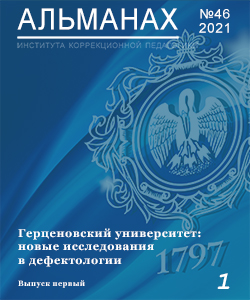Herzen University: new research in defectology
Almanac #46 · Issue #1 · 2021

Inclusive education of children with disabilities: the teacher competence through the prism of teachers’ assessments
The article presents findings of a study that was aimed to study the specifics of assessment of the importance of inclusive professional competencies of a teacher by various categories of teachers working in general education schools.
According to the results of a qualitative and quantitative analysis of the results of a survey of 416 primary school teachers, secondary school teachers of various profiles, it is stated that in assessing the importance of inclusive competencies of a teacher for achieving educational results of different types by a student with disabilities (SwD), there are significant differences in the subject factor of the area of pedagogical agenda of the teachers. Also, a significant mediating effect of this factor on the assessment of generalized parameters of the competence of a teacher of inclusive education was revealed. The factors associated with the length of service, experience of work in conditions of inclusion, do not have a significant effect on the corresponding parameters, either independently or in joint action.
The results obtained indicate the need for a differentiated approach both to determining the range of professional competencies of an inclusive teacher, and to their formation in the system of retraining and advanced training of teachers of inclusive educational organizations.
Keywords
Inclusive education of children with disabilities: the teacher competence through the prism of teachers’ assessments
inclusive educationchildren with disabilities
inclusive professional competencies of a teacher
indicator of competence
area of pedagogical agenda
Studying the Interaction of a Family and a Child with Hearing Impairment in the Conditions of the Early AID Service
The article presents the results of a pilot study of the interaction between participants (specialist, child, parent) of correctional and developmental classes in the conditions of the early aid service. The reasons that have a low impact on the establishment of contacts between parents and children with hearing impairments have been identified. One of the variants of the activity of an early care specialist is described, which helps to establish a developing interaction of a family with their child.
Keywords
Studying the Interaction of a Family and a Child with Hearing Impairment in the Conditions of the Early AID Service
sign language teachingyoung children
psychological and pedagogical support
hearing impairment
parent education
Features of Temporal Representations in Preschoolers with Severe Speech Impairments
The subject of the study was the specific features and violations of time perceptions in preschoolers with severe speech impairments (TSP) in the context of their influence on the predisposition of these children to dyscalculia.
The article presents and analyzes the results of a comparative search-ascertaining experiment, which assumed that children perform tasks of a diagnostic technique aimed at identifying in preschoolers with speech impairments the specific features of time perceptions concerning individual time intervals and the reflection of generally accepted time standards in speech. It is stated that children with TNR of senior preschool age are at the initial stage of the formation of their time perceptions, they hardly master the ability to coordinate and subordinate their movements to speech, rhythmic and visual instructions, experience significant difficulties in identifying cause-effect relationships and time perceptions in the process of composing a story on a series of plot pictures.
These negative features are one of the essential factors that determine the predisposition to dyscalculia, taking into account the need to search for and implement such forms of work to prevent this disorder, which should be correlated with the psychological structure of the process of mastering mathematics and the type of dysontogenesis of students.
Keywords
Features of Temporal Representations in Preschoolers with Severe Speech Impairments
preschoolers with severe speech impairmentstime perceptions
verbal dyscalculia
dyslexic dyscalculia
mathematical
prevention
specific disorders
Children with Visual Impairment: the Specificity of Social Interaction with Peers in the Educational Process
Keywords
Children with Visual Impairment: the Specificity of Social Interaction with Peers in the Educational Process
children with visual impairment; blindvisually impaired
children with functional visual impairment; social interaction
readiness for social interaction; components of social interaction
socio-perceptual readiness
readiness to communicate and implement joint activities in the process of social interaction
Age Features of the Educational Motivation of First Graders with Intellectual Disabilities
Keywords
Age Features of the Educational Motivation of First Graders with Intellectual Disabilities
learning activitylearning motivation
motives of learning activity
children with intellectual disabilities
first graders
Textual Competence of Primary School Children with Dysgraphy: Diag-nostic Experience
Keywords
Textual Competence of Primary School Children with Dysgraphy: Diag-nostic Experience
unity of the textrhema
semantics
coherence
meaning
text
textual competence
integrity
Specifics of Understanding Difficult Life Situations in Teenagers with Mental Retardation
Keywords
Specifics of Understanding Difficult Life Situations in Teenagers with Mental Retardation
understandingthinking
analytical-synthetic activity
attitude
self-esteem
level of anxiety
teenagers with mental retardation
Personal Resources of Social Rehabilitation of Persons with Сongenital and Acquired Visual Pathology
Keywords
Personal Resources of Social Rehabilitation of Persons with Сongenital and Acquired Visual Pathology
late-onset blindvisually impairedinternality
personal resources
locus of control
blind people
rehabilitation potential
born blind
social rehabilitation
externality